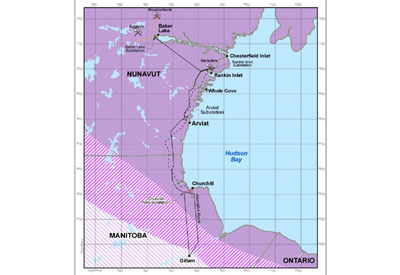Inuit org to Lobby for Nunavut-Manitoba Power Link

October 26, 2017
A road to bring cheap, clean power and internet northwards—and, at the same time boost the economy in central Nunavut: that’s what the Kivalliq Inuit Association wants for the future.
On those goals, the KivIA sounds a lot like the Kitikmeot Inuit Association on its western Nunavut Grays Bay port and road project, which has received $2 million from the Government of Nunavut to pay for the permitting process for the project.
After the territorial election Oct. 30, and a new premier and cabinet are chosen, the KivIA plans to head to Iqaluit “to move our priorities forward.”
“What’s holding us up right now is the elections,” said KivIA President David Ningeongan, after he delivered his organization’s report to the Nunavut Tunngavik Inc. annual general meeting in Cambridge Bay.
In his report to the AGM, which got underway Oct. 24, Ningeongan outlined the Kivalliq region’s priorities, which he suggested had been largely sidelined by the GN.
These include a power line running north from Manitoba—for which the KIA has now commissioned an updated feasibility study. Along with the power line would come high-speed internet via fibre-optic cable and, in a second-phase, an all-season road, which would open the region to southern Canada.
The initial project, after its permitting process, would take about three years to build.
In 2015, a report, commissioned by the KivIA, said connecting the Kivalliq to Manitoba’s electrical power grid would be economically viable, environmentally beneficial and should move forward without delay.
The plan would see the existing power line feed from Gillam, Man., which currently ends at Churchill, built north to Arviat, Whale Cove, Rankin Inlet, Chesterfield Inlet and Baker Lake.
The estimated cost of the project in 2015 stood at about $904 million, according to the analysis prepared for the KIA by engineering firm BBA Inc.
But it also suggested the project would pay for itself over its estimated 40-year lifetime, delivering projected savings of $40 million a year by replacing fossil fuels from dirty, expensive diesel generators with cleaner hydroelectric power that would mean a drop of 380,000 metric tonnes of greenhouse gas emissions in the region.
The transmission line could also extend to mines in the region and would see electricity prices drop from an average of 75 cents per kilowatt hour, currently charged in the Kivalliq, to about 13 cents per kilowatt hour.
The project could also ultimately help the GN save money, because its power corporation wouldn’t have to to upgrade its infrastructure in a region where energy consumption is forecast to grow by 2035 from 38 gigawatt hours a year to 185 GWh a year.
The KIA is also looking at a project that would see the construction of a $145-million road between Chesterfield Inlet, Whale Cove and Rankin Inlet under the National Trade Corridors program.
Meanwhile, Ningeongan said the region is also looking to find a balance between caribou calving protection and development.
“We want the authories to understand that we want to protect our wildlife but we also need job creation. So we have to find a balance,” Ningeongan said.









![Guide to the Canadian Electrical Code, Part 1[i] – A Road Map: Section 52 — Diagnostic imaging installations](https://electricalindustry.ca/wp-content/uploads/2022/11/Guide-CE-Code-2.png)






